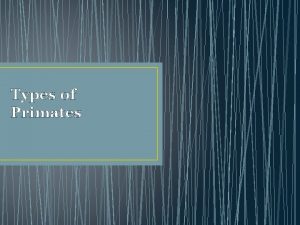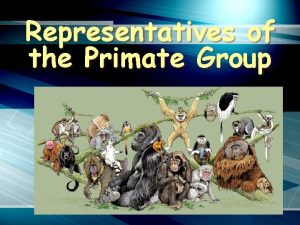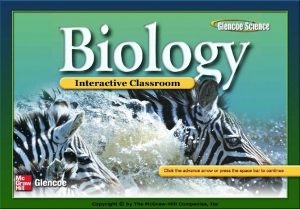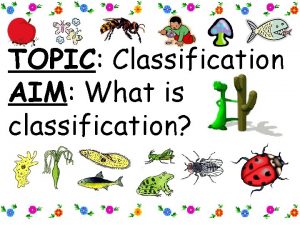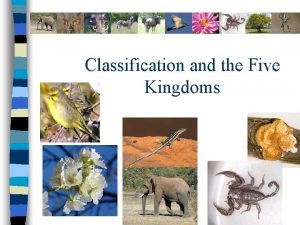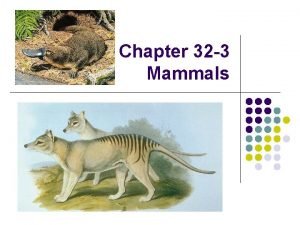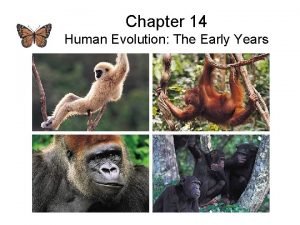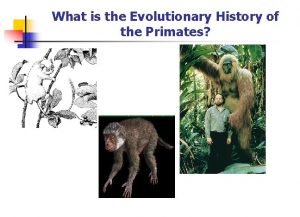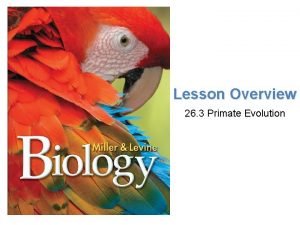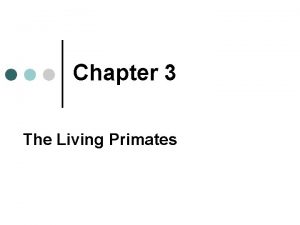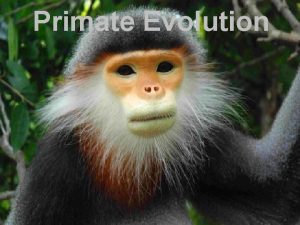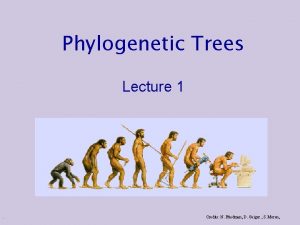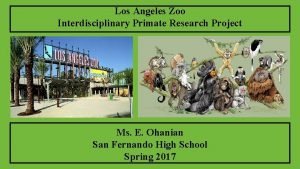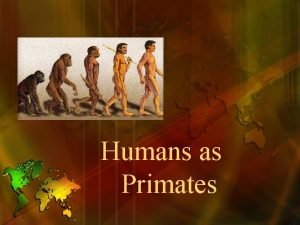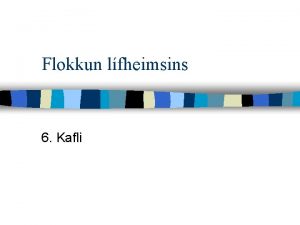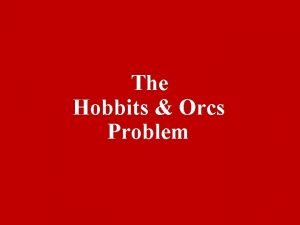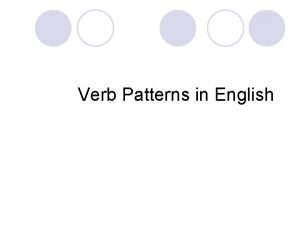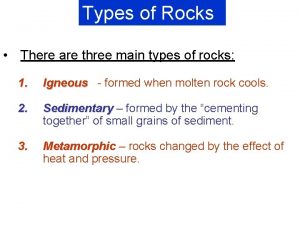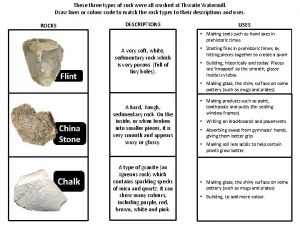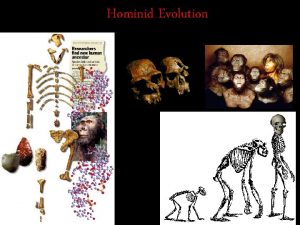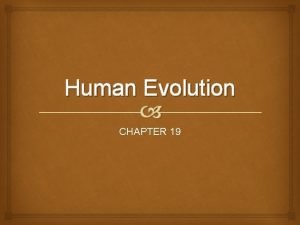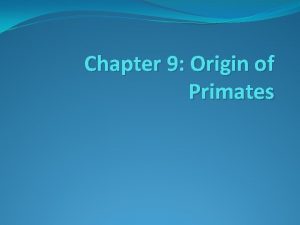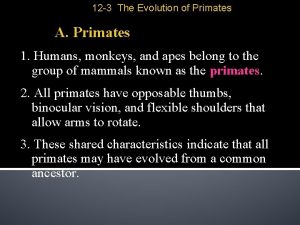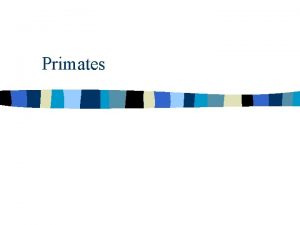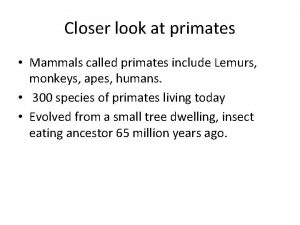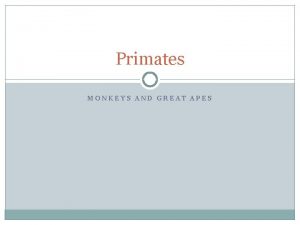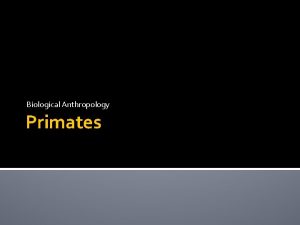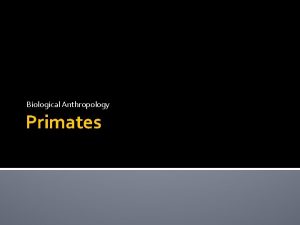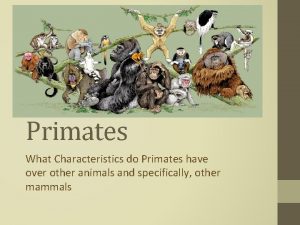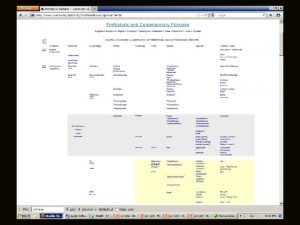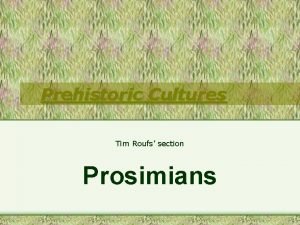Chapter 5 Primates Three types of primates Prosimians










































- Slides: 42

Chapter 5: Primates

Three types of primates Prosimians (pre-monkeys) n Monkeys (Old World and New World) n Apes n

Common Mammal Traits n n n Fur (or body hair in Humans) Long gestation & live birth (relative to other types of organisms) Heterodontism (different kinds of specialized teeth) Ability to maintain constant body temp (Homeothermy) Increased brain size (greater ability for learning and behavioral flexibility)

Hands & Feet Great degree of Prehensility n Five digits on hands/feet (contra horses) n Opposable thumb n In most- divergent & partially opposable big toe n Nails on all or some digits n Highly sensitive tactile pads on digit ends n


Question to Ponder n Why are Human Feet different?

II. Diet & Teeth Lack of dietary specialization – most primates are generalized feeders eating a wide variety of foods n Therefore, primates have a generalized dentition n

III. Senses & Brain Vision enhanced n Olfaction reduced n Complex brain n

Vision n All primates rely heavily on vision n n Color vision in Diurnal primates. Stereoscopic vision n n Eyes in front of skull, overlapping fields of vision Accurate 3 -D vision Increased depth perception Point to Ponder: Why would this be an adaptive trait? (hint: think environment)

V. Behaviors Tend to be diurnal n Increased flexibility in behavior n Tend to live in social groups n In many primate social groups, males are permanent members – unusual among mammals. n

Arboreal Adaptation Hypothesis n Traditionally, the arboreal adaptation seen as the primary factor in primate evolution n Selected for 3 -D and color vision (why? ). Grasping prehensile hands/feet to grasp Tropical arboreal environment = varied foods

Geographical Distribution

Most primates are arboreal, living in forest or woodland areas n Some Old World primates do spend considerable time on land. n No primate, except for humans, is fully terrestrial – all spend some time in trees. n

Diet & Teeth Omnivorous w/generalized dentition n Although some primates prefer some food items over others, most eat a combo of fruit, leaves, and insects. n n n Some do eat meat (chimps & baboons) Some are leaf specialists (Colobine monkey)


Teeth n Most have 4 types of teeth n Incisors and canines: biting and cutting n Premolars and molars: crushing and grinding

Each Primate species has a specific dental pattern

Locomotion Almost all primates are quadrapedal n Many use more than one form of locomotion n Long, flexible lumbar spine which provides greater propulsion from hind legs n


Two Suborders n Prosimii n n Lemurs, Lorises, Tarsiers Anthropoidea n Monkeys, Apes, Humans

Prosimians: Lemurs & Lorises n Most primitive n n n Greater reliance on olfaction (long snouts) Mark territory with scent More laterally placed eyes Shorter gestation & maturation “dental comb” (projecting lower incisors & canines)

Lemur and Loris

Lemurs n n n Madagascar Many different species (diversified in absence of competing primates) Became extinct in other areas

Lemurs Range in size from 5”, 2 oz. to +2’, 22 lbs n Larger lemurs are diurnal, omnivorous n Smaller lemurs are nocturnal, insectivores n Many forms are arboreal, others are more terrestrial n Some live in large social groups n Others (Indri) are monogamous pairs n

Lorises Similar in appearance to Lemurs n Tropical habitats (Sri Lanka, India, SE Asia, Africa) n Survived by adopting nocturnal habits n n Competition avoidance with monkeys

Lorises Slow, cautious climbing form of quadrupedalism n Bushbabies active vertical climbers and leapers n Almost entirely insectivorous n Diet supplemented with fruit, gum, leaves n

L&L Vision is stereoscopic, but less developed than anthropoids n Color vision in diurnal, but nocturnal n Grooming claw on second toe (not fully nailed) n Longer life spans than similarly sized mammals n

Tarsiers Nocturnal n SE Asia n Mated pair & offspring n Diet: insects & small vertebrates they catch by leaping from branches n

Tarsiers difficult to classify n Prosimian traits: n n Small size Grooming claws Unfused mandible Anthropoid traits n n Lack of Rhinarium (moist nose pad) Orbits fully enclosed by bone

Anthropoids (monkeys, apes, H. s) n n n n Generally larger body Larger brains in absolute and relative size Increased reliance on vision Fully forward placed eyes; bony plate back of eye socket; greater degree of color vision Fused mandibles; less specialized dentition Female anatomy different; longer gestation; longer maturation; increased parental care More social interaction

Monkeys ~ 70 % of all primates are monkeys n Two types: n n n Old World or Catarrhini (downward-facing nose) New World n n Callitrichidae Cebidae

New World Monkeys n n n Wide flaring noses with nostrils that face outward Almost exclusively arboreal Prehensile tails No fully opposable thumb. With one exception, diurnal Two Groups: n n Callitrichidae Cebidae

Callitrichids n Small Marmosets and Tamarins

Marmosets and Tamarins n Most primitive monkeys n n n Retain claws instead of nails (used like squirrels to climb trees) Twins rather than single births Family groups n n n Mated pair 2 males & 1 female Males very much involved in infant care

Cebids Larger than callitrichids n 30 species n Diet varies with combo of fruits & leaves n Most are quadrupedals n Spider monkeys are semibrachiators n


Old World Monkeys

Old World Monkeys and Apes Nostrils are set close together and face downward. n Never have a prehensile tail, n Can have opposable thumb. n

Still finding new monkeys n n April 22, 2000: Conservation International announced the discovery 2 new marmoset species in the Amazon Basin of Brazil. Both species are squirrel size. They have been named Callithrix manicorensis and Callithrix acariensis. Since 1990, ten new monkey species have been discovered in Brazil.

Hominoids (apes & humans) n Super-family includes: n n n Less apes: gibbons and siamangs Great apes: gorillas, orangutans, chimps Humans (family Hominidae)

Hominoid traits Lack of tail n Larger body size (except in lesser apes) n Shortened trunk n Different musculature in shoulder joint n More complex behavior n Longer infant development & dependence n More complex brains n

Hominoids
 Difference between prosimii and anthropoidea
Difference between prosimii and anthropoidea Prosimian primates
Prosimian primates Chapter 16 primate evolution study guide answer key
Chapter 16 primate evolution study guide answer key Primate taxonomy upsc anthropology
Primate taxonomy upsc anthropology Genus and species examples
Genus and species examples Site:slidetodoc.com
Site:slidetodoc.com Animal pyramid kingdom
Animal pyramid kingdom Order primates
Order primates Bipedal
Bipedal Apidium dental formula
Apidium dental formula Evolution of primate
Evolution of primate Primates
Primates Baby predental da sueño
Baby predental da sueño Primates
Primates Evolution of primates
Evolution of primates Primates characteristics
Primates characteristics Human phylogenetic tree
Human phylogenetic tree Old world monkeys
Old world monkeys Primates characteristics
Primates characteristics Primates
Primates Arboreal hypothesis
Arboreal hypothesis Orc and hobbit problem
Orc and hobbit problem Othello act 3 summary
Othello act 3 summary In three minutes write three things you did yesterday
In three minutes write three things you did yesterday Orange, diamond-shaped signs warn the motorist of:
Orange, diamond-shaped signs warn the motorist of: The three colonial sections-one society or three
The three colonial sections-one society or three Three address code examples
Three address code examples Three types of word parts
Three types of word parts Three types of shakespeare plays
Three types of shakespeare plays What is the difference between weathering and erosion
What is the difference between weathering and erosion Verb patterns
Verb patterns Three types of solids
Three types of solids What are the three types of sentences
What are the three types of sentences What are the three main types of rocks
What are the three main types of rocks There are three types of
There are three types of Low gray clouds
Low gray clouds Claims of facts examples
Claims of facts examples Irony poetic devices
Irony poetic devices Verbal irony definition
Verbal irony definition Characteristics of igneous rocks
Characteristics of igneous rocks Translate
Translate Three types of shakespeare plays
Three types of shakespeare plays Biliary atresia
Biliary atresia
